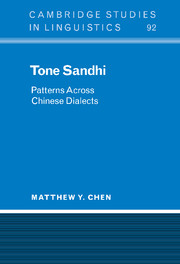Book contents
- Frontmatter
- Contents
- Preface
- Notational conventions
- 1 Setting the stage
- 2 Tonal representation and tonal processes
- 3 Directionality and interacting sandhi processes I
- 4 Directionality and interacting sandhi processes II
- 5 From base tones to sandhi forms: a constraint-based analysis
- 6 From tone to accent
- 7 Stress-foot as sandhi domain I
- 8 Stress-foot as sandhi domain II
- 9 Minimal rhythmic unit as obligatory sandhi domain
- 10 Phonological phrase as a sandhi domain
- 11 From tone to intonation
- Concluding remarks
- Bibliographical appendix Tone sandhi across Chinese dialects
- References
- Subject index
- Author index
3 - Directionality and interacting sandhi processes I
Published online by Cambridge University Press: 24 October 2009
- Frontmatter
- Contents
- Preface
- Notational conventions
- 1 Setting the stage
- 2 Tonal representation and tonal processes
- 3 Directionality and interacting sandhi processes I
- 4 Directionality and interacting sandhi processes II
- 5 From base tones to sandhi forms: a constraint-based analysis
- 6 From tone to accent
- 7 Stress-foot as sandhi domain I
- 8 Stress-foot as sandhi domain II
- 9 Minimal rhythmic unit as obligatory sandhi domain
- 10 Phonological phrase as a sandhi domain
- 11 From tone to intonation
- Concluding remarks
- Bibliographical appendix Tone sandhi across Chinese dialects
- References
- Subject index
- Author index
Summary
The nature of the problem
In this chapter and the next we take up the question of how sandhi processes are implemented and how they interact with each other.
Certain types of tone sandhi operate across the board within a certain domain. Thus, the Wu dialect of Tangxi, a left-prominent and right-spread prototype, retains the initial tone, obliterates all subsequent tones, and extends the initial tone rightwards over the entire phonological word, regardless of either the number of syllables or how the syllables are structured prosodically or morphosyntactically (see chapter 7, section 2.2). Similarly, within a tone group of indefinite length, Xiamen simply replaces every non-final base tone by its corresponding sandhi tone (see chapter 10). In either case, tone sandhi generates the output in one sweep, so to speak, and there is no question about how sandhi processes interact with each other.
There are of course sandhi processes of a more “local” nature which do not interact with each other; in such cases the output simply represents the sum of the changes brought about by the individual rules. The simplest case is illustrated below. The north-eastern Min dialect of Fuqing reported in Feng (1993) has these two rules: (i) one turns a non-final high-falling tone HM into H, as shown in (1a) and (b); (ii) the other lowers a high tone H when followed by a low tone L, as instantiated in (1c).
- Type
- Chapter
- Information
- Tone SandhiPatterns across Chinese Dialects, pp. 98 - 149Publisher: Cambridge University PressPrint publication year: 2000



